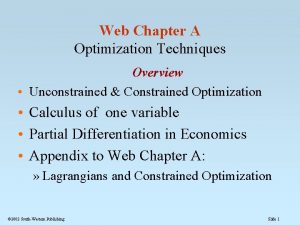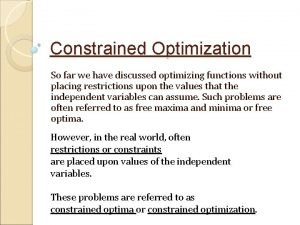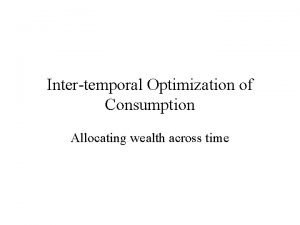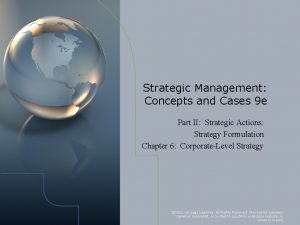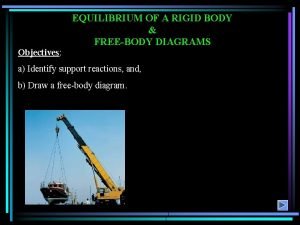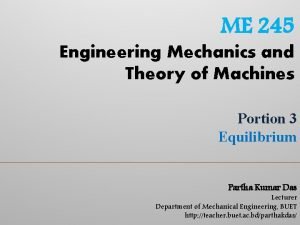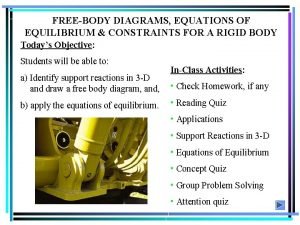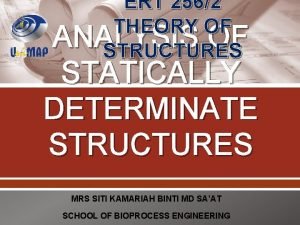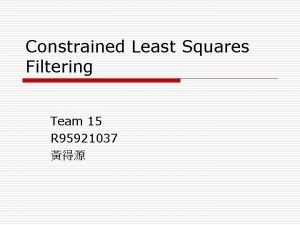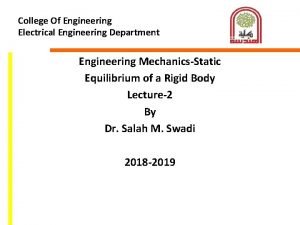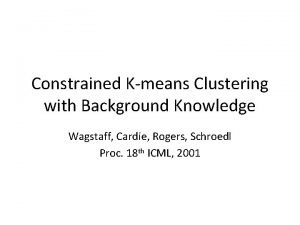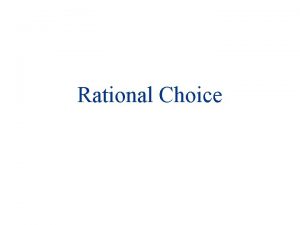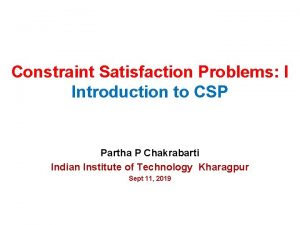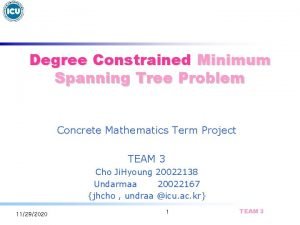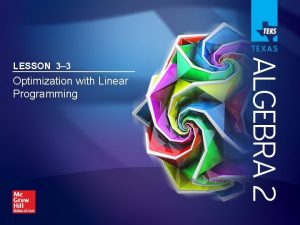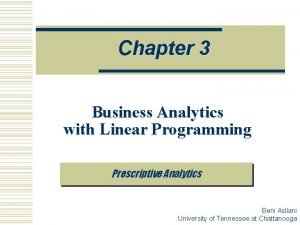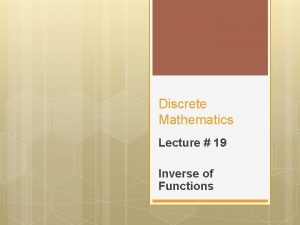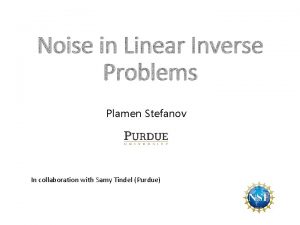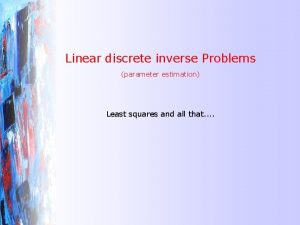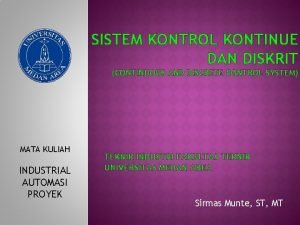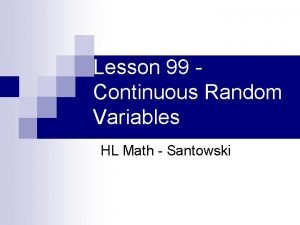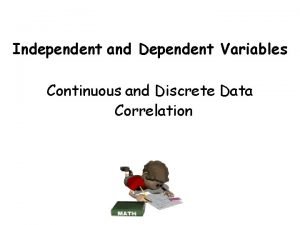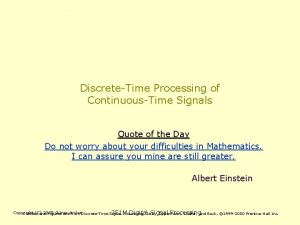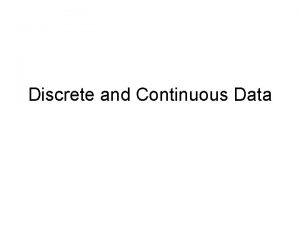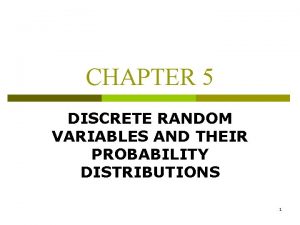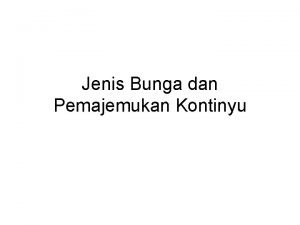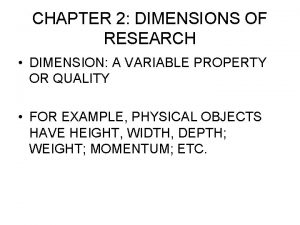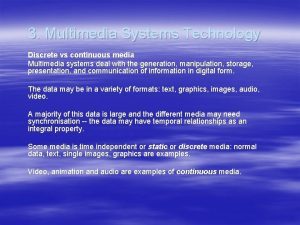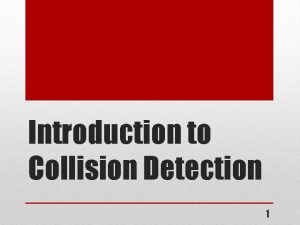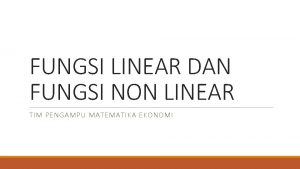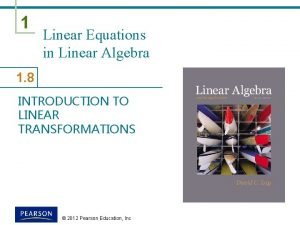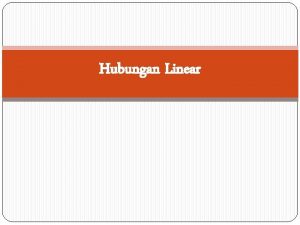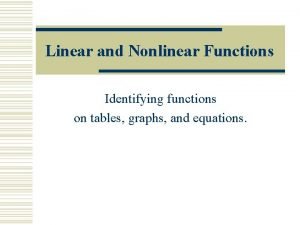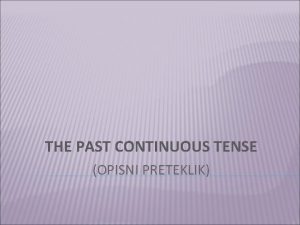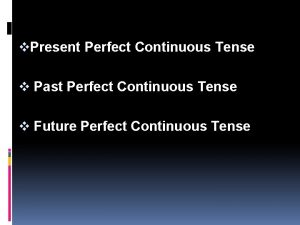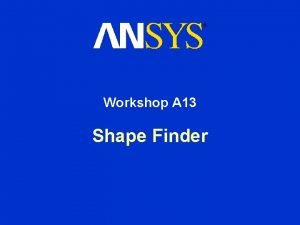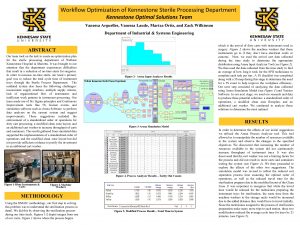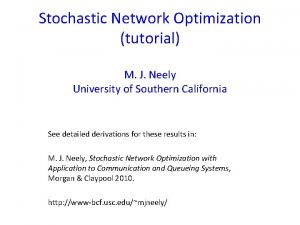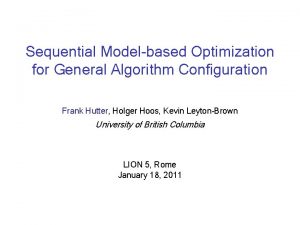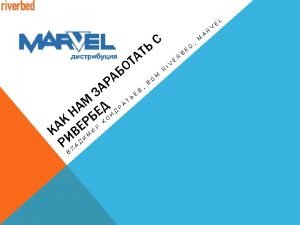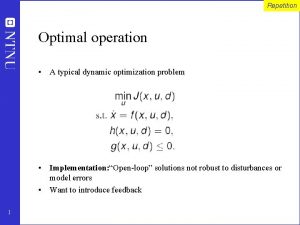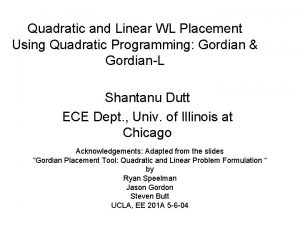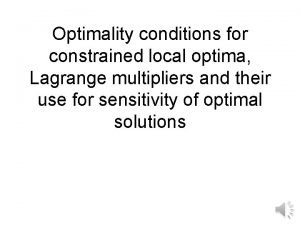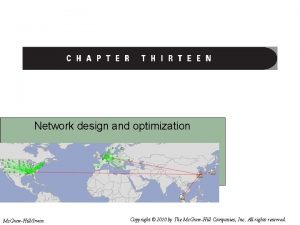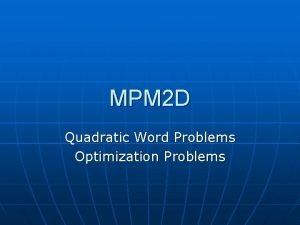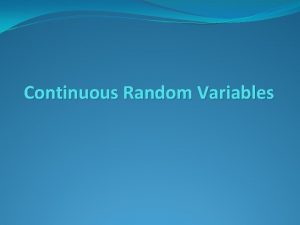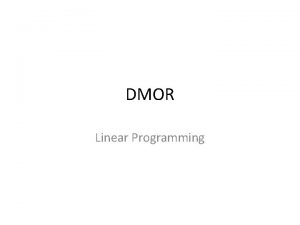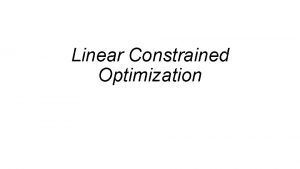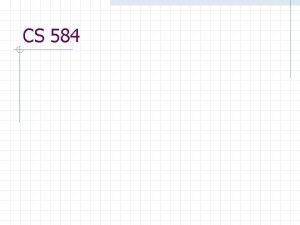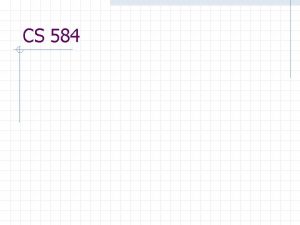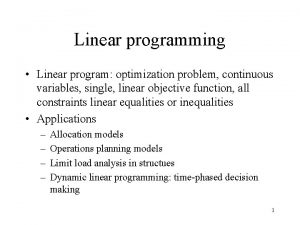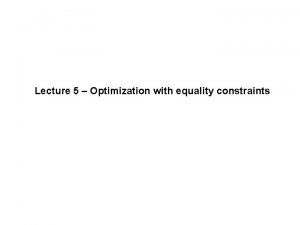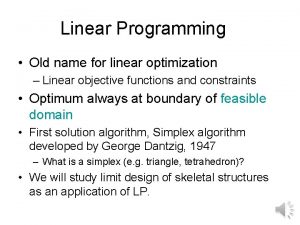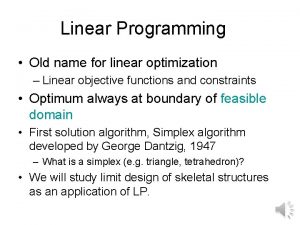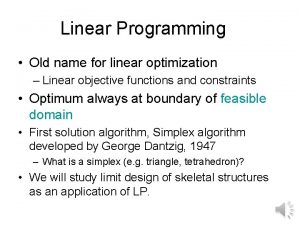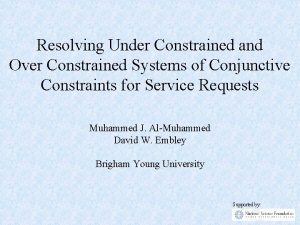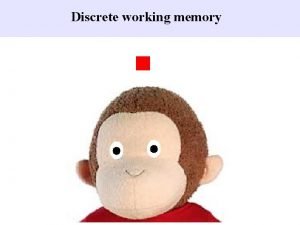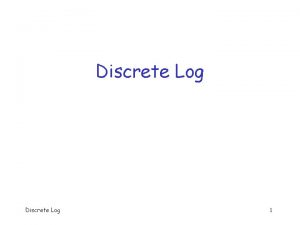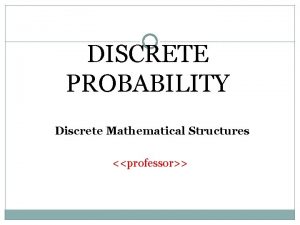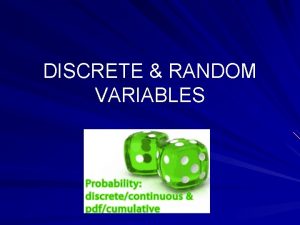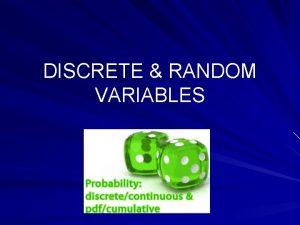Constrained Optimization 3 8 Continuous or Discrete Linear




































































































- Slides: 100


Constrained Optimization 3 -8 Continuous &/or Discrete Linear + Cross-products (interactions) Good predictions of effects and interactions 2 -Level Factorial (+ Center Points)

Relative Importance of Three Stages of Experimentation U U-Unconstrained Optimization (Response Surfaces Chapter 10) C S C-Constrained Optimization (Main effects and interactions) S-Screening Experiments (What Factors are important)


A Poor Solution is to Use One-at-a-Time Experiments Run 1 2 + 3 4 5 6 7 8 9 - A - - + - - - B - - + - - - - C - - - + - - D + E F G H

Fractional Factorial Experiments • Method for Strategically Picking a Subset of a 2 k Design • Used for Screening purposes • Has much Higher Power for detecting Effects through hidden replication • Can be used to estimate some interactions and limited optimization

Half-Fraction of 23 I=C A=C I = ABC

Paradigms That Justify Use of Fractional Factorials • •

Hierarchical Ordering Principle Venus – Moon – Jupiter align Jupiter Mars Venus Crescent Moon ▪Although its possible that three planets may align with the moon, its more often that two planets will align with moon than three ▪Likewise though three factor interactions and higher order interactions are possible, its more likely that large effects will be main effects or two factor interactions




Creating a half fraction design in SAS



I = ABCDE







Would these conclusions have been reached using one at a time experimentation?

· In a one half fraction of a 2 experiment every effect that could be estimated was confounded with one other effect, thus one half the effects had to be assumed negligible in order to interpret or explain the results In a one quarter fraction of a 2 k experiment every effect that can be estimated is confounded with three other effects, thus three quarters of the effects must be assumed negligible in order to interpret or explain the results k · · In a one eighth fraction of a 2 experiment every effect that can be estimated is confounded with seven other effects, thus seven eights of the effects must be assumed negligible in order to interpret or explain the results, etc. k

Creating a 2 k-p Design 1. Create a full two-level factorial in k-p factors 2. Add each of the remaining p factors by assigning them to a column of signs for an interaction among the first k-p columns

These are the generators

the generators the generalized interaction the defining relation

Defining Relation Confounding Pattern or Alias Structure

26 -3 design base design in 6 -3 = 3 Factors A, B, C

The three factor generalized interaction is The defining relation is

Select Design… Design ► Define Variables… ► Add> New Two-Level

Example ¼ Fraction of 26 One possible set of generators is: Resulting in the following Alias Structure

Another possible set of generators is: Resulting in the following Alias Structure

Resolution as a criteria for choosing generators R, the resolution, is the length of the shortest word in the defining relation. Resolution III – main effects confounded with two-factor interactions Resolution IV – main effects confounded with three-factor interactions, and two factor interactions confounded with other two-factor interactions Resolution V – main effects confounded with four-factor interactions, two-factor interactions confounded with three-factor interactions. In this case if you are willing to assume three factor interactions and higher are negligible, you can estimate all main effects and two factor interactions Higher Resolution means main effects are confounded with higher order interactions

Minimum Aberration as a criteria for choosing generators d 1 F = ABCD, G = ABCE I = ABCDF = ABCEG = DEFG d 2 F = ABC, G = ADE I = ABCF = ADEG = BCDEFG Which is better? Word length pattern: length 3 d 1 d 2 (0, 1, 2) (0, 2, 0, 1) length 4 length 5

Symbolically: (A 3, A 4, A 5, …) Ar is number of words of length r

Number of clear Effects as a criteria for choosing generators An effect is defined to be clear if none of its aliases are main effects or two factor interactions See Example 64. sas

Only 56% Eucalyptus used in Brazilian forests acid treatment Hemicellulose hydrolyzate Edible Biomass rich in essential amino acids Paecilomyces variolii Fermentation


Generators for minimum aberration






BH

EG Maximum appears to be with Ammonium Sulfate and Sodium Phosphate both at 2 g/L

CH

BEG

Recap 8 Factors would require 28 = 256 for full factorial 16 + 8 = 24 resulted in plausible interpretation and identification of optimal results Label Factor Optimal Setting B Rice Bran 30. 0 g/L E Ammonium Sulfate 2. 0 g/L G Sodium Phosphate 0. 0 g/L


Reverse signs of coded factor levels for Factor B



Example +

Creating Design Augmented by Foldover in SAS Data Step ADX

Augmenting a resolution IV by mirror image or foldover does not break strings of confounded two factor interactions , H=ABD Augment by design with signs reversed on Factor A only


Augment by design Reversing signs on A

Example: High concentration of arsenic reported in ground water in countries such as Bangladesh, Chile, India, Poland, Nepal … causing people to be prone to various forms of cancer

Simple IOCS filters have been used in Bangladesh and Nepal to remove arsenic from ground water

Simple household filters are effective raw water iron oxide coated sand pourous membrane purified water

IOCS Coating solution made of ferric nitrate and sodium hydroxide with NAOH added to control p. H. Age Coating Solution Pour over clean sand yes Mix Dry Filter Spiked Water Sample repeat Mix Coating Solution no Ramakrishna et. al. (2006) conducted experiments to optimize The coating process.








What can be done to separate AD+CF

AD CF 17 18 19 20 3 3 + + 0 0 0 0 + + + + + + + No longer orthogonal Fit model Y=A B F AD CF by regression


Exchange Algorithm for maximizing det(X’X) Candidate x’s -1, -. 5, 0, . 5, 1 Step 1 replace 0 with -1 Step 3 replace. 5 with 1 Step 2 replace -. 5 with -1

Choose additional runs to maximize the



●Plackett-Burman Designs are Resolution III, but there is no defining relation ●Main Effects are confounded with two-factor interactions, but rather than being completely confounded with a few two-factor interactions, they are partially confounded with many two-factor interactions Alias Matrix shows the alias structure

Example

Implications of Partial Confounding 1. We can use Alias matrix to determine what two-factor interactions are confounded with large unassigned effects 2. Models involving main effects and some partially confounded can be fit by regression since X‘X matrix is not saingular

Creating a Plackett-Burman Design in SAS


Read in the data and merge it with the design created earlier Fit the model and output the parameter estimates



Create interactions and do all subsets regression




OA(12, 31, 24) Run 1 2 3 4 5 1 0 0 0 2 0 0 1 3 0 1 1 4 0 1 1 1 0 5 1 0 0 1 1 6 1 0 1 1 0 7 1 1 0 0 1 8 1 1 1 0 0 9 2 0 0 10 2 0 1 11 2 1 0 0 0 12 2 1 1





Data Similar to Experiment with Teaching Methods in Chapter 2




Dummy variables represent effect of chair style

 Constrained nodes and constrained networks
Constrained nodes and constrained networks Constrained nodes and constrained networks
Constrained nodes and constrained networks Scada transport over llns with map-t
Scada transport over llns with map-t Constrained and unconstrained optimization in economics
Constrained and unconstrained optimization in economics So far we have discussed
So far we have discussed Constrained optimization
Constrained optimization Constrained optimization
Constrained optimization Present past continuous
Present past continuous Past simple future simple
Past simple future simple What is related constrained diversification
What is related constrained diversification Corporate relatedness vs operational relatedness
Corporate relatedness vs operational relatedness Constraints and statical determinacy
Constraints and statical determinacy Improperly constrained
Improperly constrained Verification engineer
Verification engineer Improperly constrained
Improperly constrained Statically determinate and indeterminate structures
Statically determinate and indeterminate structures Explain the constrained least square filtering.
Explain the constrained least square filtering. Improperly constrained
Improperly constrained Billenko
Billenko Rational constrained choice
Rational constrained choice Csp algorithm
Csp algorithm Scheduling resources and costs
Scheduling resources and costs Degree constrained spanning tree
Degree constrained spanning tree Scheduling resources and costs
Scheduling resources and costs Deep neural networks and mixed integer linear optimization
Deep neural networks and mixed integer linear optimization 3-3 optimization with linear programming
3-3 optimization with linear programming Linear optimization and prescriptive analysis
Linear optimization and prescriptive analysis Inverse functions linear discrete
Inverse functions linear discrete Inverse functions linear discrete
Inverse functions linear discrete Inverse functions linear discrete
Inverse functions linear discrete Perbedaan continuous dan discrete
Perbedaan continuous dan discrete Continuous random variable example
Continuous random variable example Independent variable is what axis
Independent variable is what axis Independent variable is what axis
Independent variable is what axis Discrete time processing of continuous time signals
Discrete time processing of continuous time signals Continuous data
Continuous data Standard deviation of a discrete random variable
Standard deviation of a discrete random variable Rumus bunga kontinu
Rumus bunga kontinu Dimensions of research
Dimensions of research Discrete or continuous data
Discrete or continuous data Discrete media meaning
Discrete media meaning Lesson 19 collision detection
Lesson 19 collision detection Nominal, ordinal, discrete, continuous
Nominal, ordinal, discrete, continuous Simple and multiple linear regression
Simple and multiple linear regression Contoh soal metode biseksi dan penyelesaiannya
Contoh soal metode biseksi dan penyelesaiannya Linear and nonlinear text
Linear and nonlinear text What's a nonlinear plot
What's a nonlinear plot Contoh soal persamaan non linear dengan metode biseksi
Contoh soal persamaan non linear dengan metode biseksi Linear and nonlinear pipeline
Linear and nonlinear pipeline Non linear multimedia examples
Non linear multimedia examples Left linear grammar to right linear grammar
Left linear grammar to right linear grammar Contoh soal fungsi non linier
Contoh soal fungsi non linier Fungsi nonlinier
Fungsi nonlinier Linearly independent
Linearly independent Linear algebra linear transformation
Linear algebra linear transformation Hubungan linear dan tak linear
Hubungan linear dan tak linear Linear momentum and linear impulse
Linear momentum and linear impulse Simultaneous equations linear and non linear
Simultaneous equations linear and non linear Linear vs nonlinear tables
Linear vs nonlinear tables Nonlinear tables
Nonlinear tables Difference between linear and nonlinear equation
Difference between linear and nonlinear equation Nonlinear video editing
Nonlinear video editing Metode gauss naif
Metode gauss naif Closure properties of regular languages
Closure properties of regular languages Tipos de narrador de texto
Tipos de narrador de texto Past continuous tense of cut
Past continuous tense of cut Past proggresive
Past proggresive Past simple past perfect and past continuous exercise
Past simple past perfect and past continuous exercise Past continuous present continuous
Past continuous present continuous Past simple past continuous or past perfect
Past simple past continuous or past perfect Future perfect and future continuous examples
Future perfect and future continuous examples Jitsmi
Jitsmi Continuous auditing continuous monitoring
Continuous auditing continuous monitoring Present perfect and past continuous
Present perfect and past continuous Future perfect simple continuous
Future perfect simple continuous Present perfect continuous auxiliary verb
Present perfect continuous auxiliary verb Present simple past simple present continuous exercises
Present simple past simple present continuous exercises Past perfect
Past perfect Shape optimization ansys
Shape optimization ansys Instrument processing optimization
Instrument processing optimization Amager resource center
Amager resource center Global optimization toolbox
Global optimization toolbox Stochastic optimization tutorial
Stochastic optimization tutorial Sequential model-based optimization
Sequential model-based optimization Seo off page optimization tutorial
Seo off page optimization tutorial Nichebot keyword tool
Nichebot keyword tool Supply chain optimization python
Supply chain optimization python Sas adaptive customer experience
Sas adaptive customer experience Magic quadrant for wan optimization controllers
Magic quadrant for wan optimization controllers Quadratic optimization problems
Quadratic optimization problems Quadratic programming problem example
Quadratic programming problem example Mainframe mips optimization
Mainframe mips optimization Relative vs absolute max and min
Relative vs absolute max and min Optimization problems
Optimization problems Hfss optimization
Hfss optimization Lagrangian optimization
Lagrangian optimization Unimodal function
Unimodal function Network design and optimization
Network design and optimization Quadratic word problems
Quadratic word problems Microsoft application virtualization
Microsoft application virtualization Microsoft desktop optimization pack download
Microsoft desktop optimization pack download



